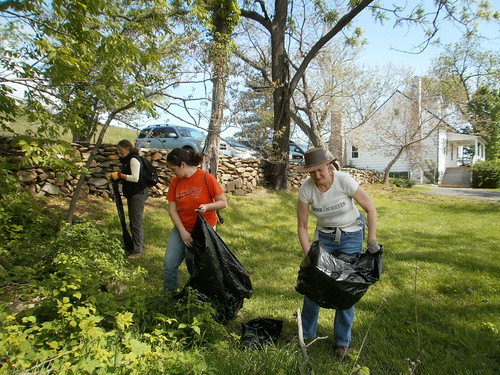The real title of this article is "Invasive Alien Plant Species of Virginia." But in my head swirled a dozen humorous scenarios about Virginia being invaded, or again (with this being the Sesquitennialof the Civil War). But really, this is serious business we are talking about, nothing to joke about!

Invasive Species Removal Project at Sky Meadows State Park
Some of the invasives effect not only the state parks or wilderness areas, but the entire ecosystem here in the Commonwealth, this means agriculture and farming as well.
What are Invasive Alien Plant Species and Why are They a Problem? Click here for more details.
Invasive alien plants typically exhibit the following characteristics:
- -Rapid growth and maturity
- -Prolific seed production
- -Highly successful seed dispersal, germination and colonization
- -Rampant vegetative spread
- -Ability to out-compete native species
- -High cost to remove or control
An invasive plant infestation is like a slow motion explosion, which, if left unchecked, may severely alter a site's natural, economic, aesthetic, and other cultural values. Management of invasive species while maintaining these values can appear to be a complicated and unending task. For this reason, planning and prioritizing are crucial. By articulating clear goals, gathering the best available information, and prioritizing actions based on the significance of an infestation's impacts and feasibility of control, land managers can identify how their time, effort, and money can most effectively be applied. Invasive species present a difficult challenge with no quick and easy solutions. Many unknowns exist regarding control methods and their efficacy, in addition to limited budgets for managing invasive plants. Sometimes, the best course of action may be to do nothing.
The following are some of the most troublesome species in Virginia. Click on any of the highlighted species to view, save and/or print a fact sheet in .PDF format. You will need the freeAdobe Readerto read these factsheets.
Aneilima– Murdannia keisak
Asiatic sand-sedge –Carex kobomugi
Autumn Olive & Russian Olive –Elaeagnus umbellata,E. angustifolia
Bush honeysuckles –Lonicera spp.
Canada-thistle– Cirsium arvense
Chinese lespedeza –Lespedeza cuneata
Chinese privet –Ligustrum sinense
Common reed –Phragmites australis
Crown-vetch –Coronilla varia
Eurasian water-milfoil –Myriophyllum spicatum
Garlic mustard –Alliaria petiolata
Giant reed –Arundo donax
Hydrilla –Hydrilla verticillata
Japanese honeysuckle –Lonicera japonica
Japanese knotweed –Polygonum cuspidatum
Japanese stiltgrass –Microstegium viminium
Johnson-grass –Sorghum halpense
Kudzu-vine –Pueraria lobata
Mile-a-minute –Polygonum perfoliatum
Multiflora rose –Rosa multiflora
Oriental bittersweet –Celastrus orbiculatus
Parrots feather –Myriophyllum aquaticum
Porcelain-berry –Ampelopsis brevipendunculata
Purple loosestrife– Lythrum salicaria
Spotted knapweed –Centaurea maculosa
Tall fescue –Festuca elatior
Tree of heaven –Ailanthus altissima
Weeping lovegrass –Eragrostis curvala
Winged burning bush –Euonymus alatus
Other Publications
Managing Invasives in Natural Areas, Parks and Small Woodlands
How You Can Help
- 1. Use native plant species grown from local stock for conservation and landscaping purposes whenever possible. See ourlist of native plants for conservation, restoration, and landscaping.
- 2. When using alien plants, avoid highly invasive species. See ourinvasive alien plants list.
- 3. Support public policies that restrict the introduction of invasive alien plants and get involved in organizations that work to protect biodiversity.
